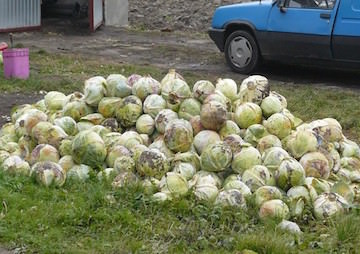Useful Waste Is a Win-Win for Energy and Food
An unsung success story in the switch to renewable energy is the use of waste to produce gas -- and a valuable byproduct. Rotting cabbages, a good source of gas that can be used as fuel. (MOs810 via Wikimedia Commons)
Rotting cabbages, a good source of gas that can be used as fuel. (MOs810 via Wikimedia Commons)
By Paul Brown / Climate News NetworkThis Creative Commons-licensed piece first appeared at Climate News Network.
LONDON — The future is increasingly bright for renewable energy, with the US aiming to cut the price of solar photovoltaics by 75% between 2010 and 2020. Denmark plans to obtain 50% of its energy from wind just five years from now.
But one form of renewable energy — and one which attracts few headlines — manages to create two useful products at the same time, and is making a growing contribution to combatting climate change.
The medieval alchemists who sought to turn base metal into gold would have thrilled at chemistry that let them turn waste into both fuel and fertiliser. Their twenty-first century successors have discovered the secret of doing exactly that.
Unwanted food, animal waste, municipal rubbish, crop and forestry residues, sewage and dozens of other left-overs of civilisation can and are now being turned into methane to generate electricity, provide district heating and to fuel road vehicles.
Big contribution
This largely unheralded revolution takes different forms across the world, mostly because governments set their own rules to encourage the technology, and also because local circumstances provide contrasting piles of waste. But in every case the waste can be converted into gas for use as fuel.
Although the technology is only part of the solution to climate change, the European Biogas Association estimates that over time it should be able to replace 30% of current natural gas consumption in Europe.
The technology is roughly the same whatever the size of the plant or its location. Biogas plants use microbes to eat waste in an oxygen-free environment to produce methane, and leave fertiliser or soil conditioner as a useful by-product. The plants vary from small household types, very popular in China and India, to farm plants and larger-scale municipal installations in Europe.
Poor relation
The potential of wind and solar power for replacing coal to produce electricity is familiar; the biogas revolution is hardly recognised. The first report on biogas produced by the International Gas Union went virtually unreported.
Yet its details included, for example: “One bag of food waste composted to biogas is enough to power a gas-driven car for almost two kilometres”, and: “A bus with 55 passengers can run for 1,000 km on the food waste produced by its passengers each year.”
Biogas is produced naturally in environments with no oxygen: swamps, for example, rice paddies and the stomachs of ruminant animals like cattle. An anaerobic digester’s microbes produce the methane by eating the organic content of the waste, leaving a nutrient-rich fertiliser as the residue.
Germany and China are the world leaders in turning farm waste into gas, with 8,000 and 24,000 farm-based plants respectively. More surprising perhaps is the fact that China has built 42 million small biogas plants in a decade to turn village waste into fuel.
Compatible mix
Usually the methane produced in these digesters is fed into generators or small power stations on site and used locally. But if it is further purified the gas can simply be fed into a pipeline and mixed with natural gas.
In Sweden, which aims by 2030 to replace fossil fuels in transport with biogas, the number of gas-driven vehicles has doubled to 50,000 in the last five years. One Swedish advance is to cool the gas to -163°C until it liquefies, reducing its volume by 600 times and making it a perfect fuel for large lorries. Demand for biogas outstrips supply in much of the country, which is now using its ample supplies of forestry waste.
Elsewhere, for example in the UK and South Korea, much biogas comes from old rubbish dumps where the methane they emit is piped to mini-power stations on site. More recently, to cut down on waste, local authorities in the UK have begun collecting thrown-away food so that purpose-built anaerobic digesters can convert it into gas and fertiliser.
Scotland, although part of the UK, has a devolved government which recognises that stronger regulation can drive the biogas revolution.
Paul Brown, a founding editor of Climate News Network, is a former environment correspondent of The Guardian newspaper, and still writes columns for the paper.
Your support matters…Independent journalism is under threat and overshadowed by heavily funded mainstream media.
You can help level the playing field. Become a member.
Your tax-deductible contribution keeps us digging beneath the headlines to give you thought-provoking, investigative reporting and analysis that unearths what's really happening- without compromise.
Give today to support our courageous, independent journalists.








You need to be a supporter to comment.
There are currently no responses to this article.
Be the first to respond.